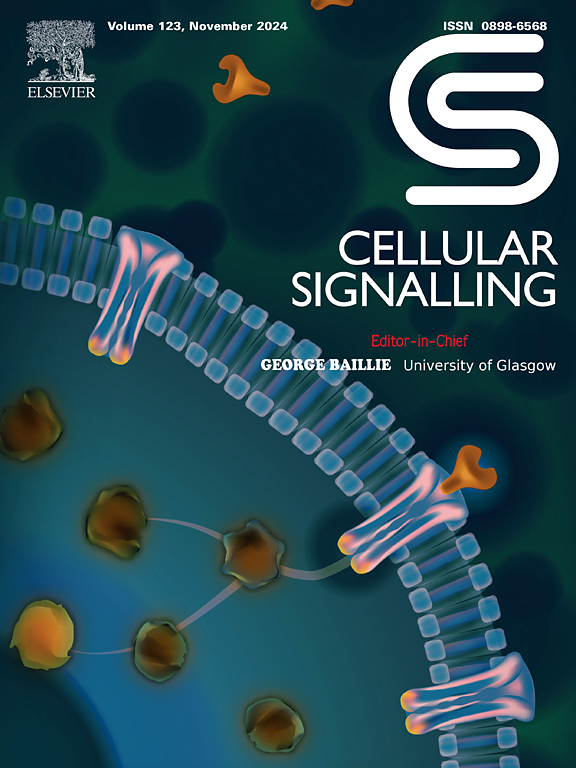乳酸通过Gpr81-Stat3信号通路诱导成骨细胞氧化磷酸化。
IF 4.4
2区 生物学
Q2 CELL BIOLOGY
引用次数: 0
摘要
乳酸长期以来被认为是糖酵解的最终产物和缺氧条件下的代谢“废物”,但最近的研究表明乳酸在能量代谢重编程和细胞间通讯中起着核心作用。然而,乳酸是否通过代谢重编程促进成骨分化仍不清楚。在这里,我们发现乳酸显著增加细胞ATP含量,激活琥珀酸脱氢酶活性,并提高成骨前MC3T3-E1细胞的耗氧量。此外,乳酸处理增加了甲状旁腺激素(PTH)处理的MC3T3-E1细胞的氧化磷酸化(OXPHOS)。微阵列和rna测序分析显示,乳酸处理或乳酸和甲状旁腺激素共处理的MC3T3-E1细胞中Stat3信号富集。免疫印迹验证分析进一步表明,乳酸激活Jak2-Stat3-Y705和Akt-Stat3-S727信号通路。AG490抑制Jak2-Stat3-Y705信号通路阻断乳酸诱导的成骨细胞分化。3-OBA抑制Gpr81或Gpr81 siRNA降低Gpr81表达,而AZD3965不中断MCT1,导致Gpr81- jak2 - stat3 - y705和Gpr81- akt - stat3 - s727信号通路受到抑制,MC3T3-E1细胞的OXPHOS和细胞分化也受到抑制。此外,我们证明Gpr81亚基Gβγ在乳酸-Gpr81信号传导中起核心作用。最后,成骨细胞gpr81缺失小鼠的成骨率较低。因此,这些发现提出了一种新的信号机制,乳酸盐通过Gpr81激活Stat3信号来调节细胞分化和OXPHOS。本文章由计算机程序翻译,如有差异,请以英文原文为准。
Lactate induces oxidative phosphorylation in osteoblasts via Gpr81–Stat3 signaling
Lactate has long been regarded as an end product of glycolysis and a metabolic “waste product” under hypoxic conditions, but recent studies have revealed that lactate plays a central role in energy metabolism reprogramming and intercellular communication. However, it remains unknown whether lactate promotes osteogenic differentiation through metabolic reprogramming. Here, we showed that lactate significantly increased the cellular ATP content, activated succinate dehydrogenase activity, and enhanced oxygen consumption rate in pre-osteoblast MC3T3-E1 cells. Moreover, lactate treatment increased oxidative phosphorylation (OXPHOS) in parathyroid hormone (PTH)-treated MC3T3-E1 cells. Microarray and RNA-sequencing analysis revealed that Stat3 signaling was enriched in MC3T3-E1 cells treated with lactate or co-treated with lactate and PTH. Immunoblotting verification analysis further showed that lactate activated the Jak2–Stat3-Y705 and Akt–Stat3-S727 signaling. Inhibition of Jak2–Stat3-Y705 signaling by AG490 interrupted lactate-induced osteoblast differentiation. Inhibition of Gpr81 by 3-OBA or decrease in Gpr81 expression by Gpr81 siRNA, but not the interruption of MCT1 by AZD3965, led to the inhibition of the Gpr81–Jak2–Stat3-Y705 and Gpr81–Akt–Stat3-S727 signaling, and OXPHOS and cell differentiation of MC3T3-E1 cells were also inhibited. Furthermore, we demonstrated that the Gpr81 subunit Gβγ plays a central role in lactate–Gpr81 signaling. Lastly, osteoblast Gpr81-deficient mice showed lower bone formation. Thus, these findings propose a novel signaling mechanism by which lactate regulates cell differentiation as well as OXPHOS through the activation of Stat3 signaling by Gpr81.
求助全文
通过发布文献求助,成功后即可免费获取论文全文。
去求助
来源期刊

Cellular signalling
生物-细胞生物学
CiteScore
8.40
自引率
0.00%
发文量
250
审稿时长
27 days
期刊介绍:
Cellular Signalling publishes original research describing fundamental and clinical findings on the mechanisms, actions and structural components of cellular signalling systems in vitro and in vivo.
Cellular Signalling aims at full length research papers defining signalling systems ranging from microorganisms to cells, tissues and higher organisms.
 求助内容:
求助内容: 应助结果提醒方式:
应助结果提醒方式:


